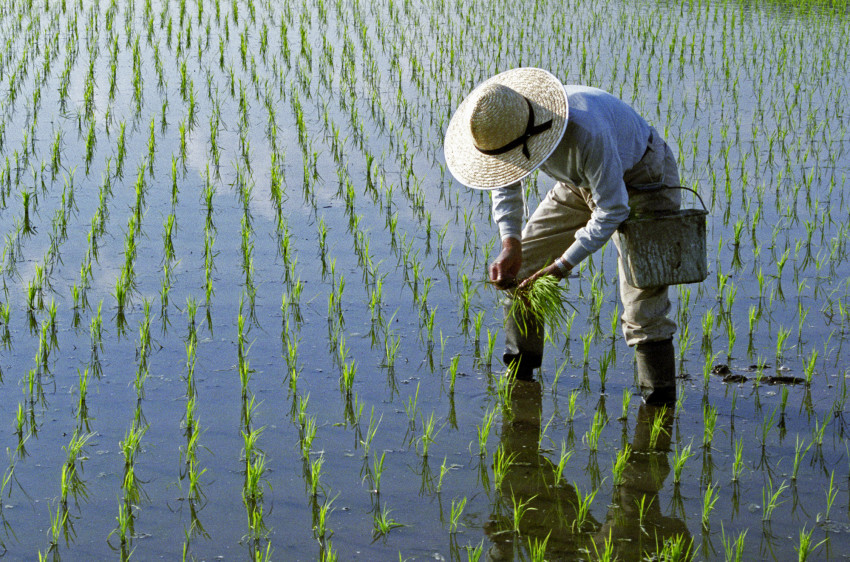
If you’ve noticed your grocery bill climbing higher, you’re not alone. Food prices in Japan spiked to their highest levels, affecting nearly 3,000 products. Extreme weather, depreciation of the yen, and the rise in energy costs are the primary culprits.
While energy costs are cyclical, and the yen’s depreciation could be managed through monetary policy, extreme weather risks to food supply chains in Japan are increasing and require immediate attention, given its unique food system economy. In 2023, Japan’s inflation rate hit a 41-year high. At the same time, Japan’s food self-sufficiency has fallen from around 50 percent in the 1980s to 38 percent today — the lowest among major advanced countries.
As countries worldwide face their own agricultural and economic challenges from climate change — droughts in the U.S., flooding in Europe, and heatwaves in South America — Japan’s reliance on foreign markets places it at a distinct risk.
Looking at the top imported foods in Japan — wheat, corn, soybean, meats, and vegetables — reveals the extent of its dependence. Without enough land to produce food for its dense population, Japan relies often on just a handful of countries for staple food items. The concentration of Japan’s food supply chain means that the country is more vulnerable than most when global conditions change.
When climate events or geopolitical tensions impact those countries, Japan’s food security becomes tenuous, leading to direct and often sharp impacts on grocery prices. Japan’s import dependence is only increasing as diets shift toward globally sourced foods. Over the last 40 years, wheat-based products like bread and pasta, for instance, have become more popular than rice in Japan .
While consumption patterns change, climate disasters disrupt food supply chains and drive up costs. Wheat prices jumped 10 percent in 2022 amid droughts, extreme heat, and floods in Canada, the U.S.
, and Australia — top suppliers for Japan — and Russia's invasion of Ukraine. This year, the price of coffee surged by nearly 20 percent, following droughts in Brazil and a typhoon in Vietnam. Intense heat and rains in West Africa contributed to a 136 percent price surge of cocoa between 2022 and 2024.
It’s not just the food that Japan imports. The quality and price of its largest domestic crop — rice — is also threatened. The production of this staple food is increasingly susceptible to erratic climate shifts and economic pressures.
The price of newly harvested rice in Japan surged 28 percent over the summer and 48 percent this fall after extreme heat reduced last season’s harvest and demand outpaced supply. If Japan does not adopt more climate resilient strategies, like heat tolerant rice varieties, crop yields could decline by 30 percent by 2050. As a result, Japan’s food security faces a double whammy: both its local crop production and the international supply chain it relies on are highly vulnerable.
If nothing changes, grocery prices will continue to rise — fueling a cost-of-living crisis while an aging population strains the economy and government resources. Addressing the global crisis of climate change requires a global solution. Japanese lawmakers face a distinct opportunity to rebuild a resilient food system and lead in climate adaptation.
One way to do this is to develop Supply Chain Climate Action plans linked to specific crops. The Japanese government in collaboration with the private companies in the food, agrochemical, and transportation sectors would lead these plans. They would first identify vulnerable global food supply chains.
Then map out areas prone to climate risks, critical transport routes, and important farming regions. Finally, they would develop strategies to reduce these risks, such as climate-resistant seeds, diversifying transport methods, investing in technology to detect hazards, and making strategic investments in growing regions/processors globally.s.
Qatar has implemented a version of these initiatives although at a smaller scale(Japan’s population is almost 35 times that of Qatar). Qatar imports nearly 100 percent of its food due to its arid climate and limited agricultural land. But the Gulf nation has taken significant steps to safeguard its food security, developing a robust, diversified food supply system that’s shielded from market and climate volatility.
A blockade in 2017 jolted Qatar into dramatically redesigning its supply chains, an effort that has continued to help insulate it from economic upheavals. When the coronavirus pandemic drove many countries into a recession and shocked supply chains, Qatar reported a fiscal surplus in 2020 — thanks to increased self-sufficiency. Qatar has heavily invested in food security by building strategic partnerships with international producers, adopting high-tech solutions like vertical farming, and cultivating a robust network of suppliers.
As an example, Hassad Foods(the fully owned subsidiary of Qatar Investment Authority) has made a strategic investment worth $1 billion in acquiring farms and processing operations globally. While Japan’s institutions differ, Qatar’s model demonstrates that even countries dependent on food imports can successfully build resilient, self-sufficient supply chains. Food security is not just about ensuring enough food for today but about creating a sustainable, diversified system that serves future generations.
The current increase in grocery prices is just the beginning of the climate premium that Japanese consumers are paying. However, Japan has an opportunity to not only lower it but create a Japan model of achieving food security resilience under climate change for other nations. *Himanshu Gupta is * CEO and co-founder of ClimateAi, a climate mitigation platform named as one of America’s Top Greentech Companies in 2024.
.














